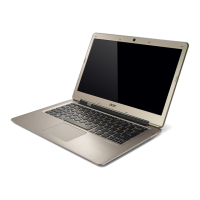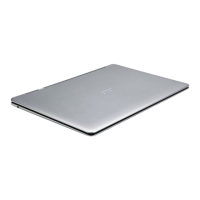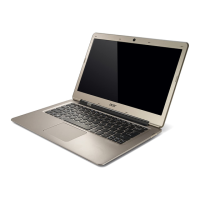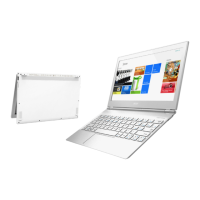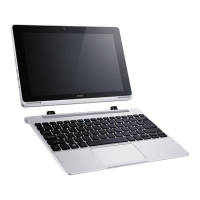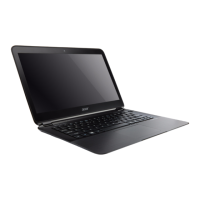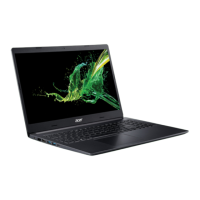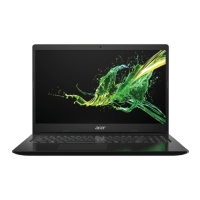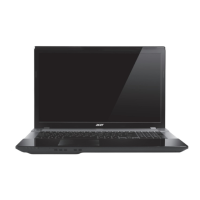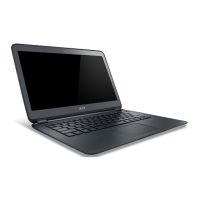
Do you have a question about the Acer Aspire S5 and is the answer not in the manual?
| Graphics | Intel HD Graphics 4000 |
|---|---|
| Battery Life | Up to 6.5 hours |
| RAM | 4GB or 8GB |
| Storage | 128GB SSD |
| Display | 13.3-inch |
| Operating System | Windows 8 |
| Weight | 1.2 kg (2.65 lbs) |
| Ports | HDMI |
| Processor | Intel Core i5 or i7 (specific generation varies by model) |
Covers general safety, power cord usage, and hearing protection guidelines.
Includes dummy cards, general handling, and disposal advice.
Information on servicing, safe battery usage, and temperature limits.
Discusses RF interference, pacemakers, hearing aids, and medical devices.
Covers explosive environments, emergency calls, and product disposal instructions.
Tips for comfortable use, posture, and reducing eye strain.
Recommendations for productive and healthy computer usage.
Introduces the Acer Aspire S5 model and its general appearance.
Identifies the webcam and screen components of the notebook.
Details power and battery status indicators on the keyboard area.
Describes the keyboard, touchpad, and built-in microphone functions.
Explains the function of the MagicFlip port door control.
Details ports and features on the rear, left, and right sides.
Covers speakers, USB, HDMI, Thunderbolt, and DC-in jack ports.
Explains cursor control and basic single-finger gestures.
Details multi-finger gestures for scrolling, zooming, and app switching.
Explains Caps Lock, Num Lock, Scroll Lock, and numeric keypad functions.
Describes special key combinations for system control like brightness and volume.
Explains keys with Windows-specific functions like Start and context menu.
Steps to create factory default and driver/application backups.
Procedures for reinstalling, system restore points, and factory resets.
Restoring system using Windows features like Reset PC.
Restoring system from USB or DVD recovery backups.
How to browse media files and photos using clear.fi.
Managing shared files and compatible devices for clear.fi.
Steps to stream media to different compatible devices.
Explains wake-up from Sleep/Deep Sleep and power indicator behavior.
Settings to conserve energy and disable fast startup for power saving.
Details on battery technology, warnings, and low battery alerts.
Process for preparing a new battery for first use and temperature limits.
Guidance on charging, optimizing life, and purchasing extra packs.
How to check battery status and respond to low battery alerts.
Instructions for battery pack installation and removal.
Steps to disconnect from accessories and move short distances.
Notebook preparation for meetings and short trips.
Guidelines for packing and transporting the computer for home.
Tips for optimizing a home workspace with additional peripherals.
Advice for international travel, power compatibility, and security checks.
Explains supervisor, user, and boot passwords for computer security.
Procedure for entering passwords and handling incorrect attempts.
Introduction to the Acer Theft Shield feature for preventing theft.
Options for using phone or Wi-Fi network for theft detection.
Activating the feature and setting hotkey combinations.
Configuration of alarm settings and notifications for the theft shield.
Explains how ports on the door connect peripherals to the computer.
Instructions for manually opening and closing the port door.
How the system indicates port door status and potential issues.
Basic steps for establishing an internet connection via wireless.
Features for faster network connections and automatic content updates.
Explanation of WLANs, their benefits, and setup components like routers.
Steps to turn the Bluetooth adapter on and off in the system.
Detailed process for connecting and pairing new Bluetooth devices.
High-speed connection supporting storage devices and external displays.
Connecting high-definition audio and video equipment via HDMI port.
Information on connecting USB peripherals to the computer.
How to configure the system's boot order through the BIOS.
Procedures for setting supervisor and boot passwords in the BIOS.
Solutions for boot problems, blank screens, and no audio.
Addresses keyboard/printer issues and requesting service.
General advice and strategies for resolving common system problems.
Lists common error messages and their recommended corrective actions.
Explains fundamental elements like Start, Tiles, and Charms.
Guides on accessing features, switching apps, and managing the desktop.
Customizing the system and managing installed applications.
Guidance on Microsoft IDs and managing IE favorites.
How to check for updates and find additional help resources.
FCC statement, cable requirements, and peripheral device regulations.
Canadian compliance (ICES-003) and LCD pixel statement.
EU conformity, wireless channels by region, and French frequency restrictions.
Country codes, Canadian RF exposure, and FCC RF safety requirements.
